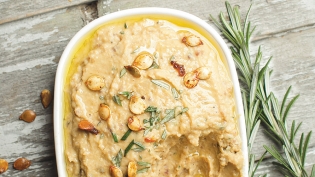Delicata Squash—“How Sweet It Is!”
I love eating winter squash, but, unfortunately, find that its tough exterior makes preparation a challenge. Trying to work with winter squash requires a bit of manual dexterity and strength. Enter the dainty delicata squash whose skin is much thinner than that of other winter squash, making it infinitely easier to work with. Delicata squash, or Cucurbita pepo (which includes cucumbers and zucchini), is an heirloom vegetable, meaning that it has been grown from seeds that have been passed down from generation to generation. Many heirlooms are grown from seeds that are at least 50 years old. Growers save the seeds from their best plants, which is why heirloom vegetables are known for their high quality and wonderful flavor, a perfect example being the delicata squash.
Delicata was around as far back as the late 1800s. During that period, demand for the squash was extremely high until it became evident that the vegetable was prone to certain diseases and had problems with yield. The squash disappeared from sight until there was a resurgence of interest in the late 1990s, when Cornell University, in response to a renewed demand for delicata, developed a disease-resistant high-yield variety called the Cornell Bush Delicata. Thanks to this discovery, delicata squash has once again returned to the produce section of grocery stores, farmers’ markets and dining room tables. Other varieties of this species include the Sweet Dumpling, which is good stuffed; Sugar Loaf, an oval-shape variety; and Honeyboat, which is very sweet. Delicata is also known as Bohemian squash, sweet potato squash and peanut squash.
For those who are not familiar with this winter squash, the delicata is cylindrical in shape. A ripe delicata will be yellow in color with green striations; when unripe it has a light-green hue. When shopping for delicata do not select a squash with soft spots, dull coloring, wrinkled skin or one that feels light for its size. On an average, delicata are five to six inches in length and two to three inches in diameter. They usually weigh around one to two pounds. The flesh of the squash is firm and fine grained with a color that ranges somewhere between a yellow to orange shade. Its flavor is delightful, much like that of a sweet potato: moist, sweet and savory.
Delicata is a relatively inexpensive squash. It is the perfect beginner’s squash because of the ease of preparation and management. Remove the skin if desired, but there is no need to do so. The squash is easier to manage if you cut off the ends. After the ends are removed, stand the squash perpendicularly and slice down the middle. Remember to remove the seeds and membranes. Helpful Hint Alert: A grapefruit spoon makes it easier to scoop out the seeds and stringy membranes. Next, lay both halves flat on a cutting board and begin slicing, dicing, chopping or stuffing.
The squash can be baked, boiled, roasted, steamed, pureed or sautéed. Its sweet, nutty flavor makes a delicious addition to soups, salads and entrées. Baking is a good choice, and the most common method of preparation because it preserves the nutrients and accentuates the delicata’s sweet flavor. The squash holds its shape well when baked, a tasty choice for stuffing with meats, cheeses, fruits, vegetables or simply a dusting of your favorite seasonings. Just slice the delicata in half lengthwise; there is no need to peel as the skin can be eaten when baked. This is true for boiled or roasted delicata squash as well. When baking, place the skin-side down in a dish with ½ inch of water and season or stuff to taste. Cover and bake for 30 to 45 minutes at 375°. If using the microwave, cook for 20 minutes in a dish that is loosely covered with plastic wrap. Keep in mind that because delicata is smaller, and has thinner skin, it cooks faster than other winter squash.
You can bake the delicata’s seeds. Wash the seeds well and pat dry, and then place on a cookie sheet in a single layer. If you let the seeds dry completely, they will crisp up nicely when baked. Toss the dried seeds with one teaspoon of olive oil per squash until coated and place on your cookie sheet. Season with sea salt and bake in a 325° oven. Turn every 10 minutes until the seeds are golden brown, and in about 20 minutes you have a healthy, delicious snack.
For those who may be gluten intolerant and desire an alternative to wheat pasta, cut your delicata into ribbons, or noodle-shaped slices, and top with your favorite tomato sauce or topping. The slices, or ribbons, make a tasty meal when raw. Whether you decide to remove the skin will depend upon your personal preference. Gluten intolerant or not, this makes a healthy dish for anyone who is searching for a wholesome mealtime option.
Nutritionally, delicata is an excellent source of vitamins A and C, fiber and potassium. It is free of fat and saturated fats, cholesterol and sodium. One cup of cooked squash contains approximately 100 calories. Deep-colored squash like delicata offer the most beta-carotene. Be aware that a cup of delicata contains about four grams of sugar.
Delicata squash is best from August to October. It can be stored in a cool, dry place for up to three months. Its tender skin reduces storage time in comparison to other hard-skinned winter squash. Try to keep the temperature at about 50° to 60°. You can also freeze your cooked delicata. Just scoop the cooked squash into freezer bags, label, and place in your freezer to enjoy whenever you feel like partaking of this sweet, nutty vegetable. Delectable delicata, a winter squash by any other name would not taste as sweet!
Tracey Medeiros likes to keep it local and seasonal in her kitchen.







